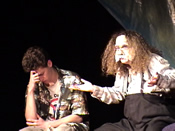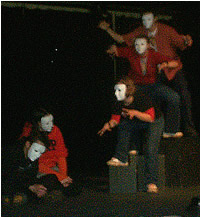

Unit
3 - Character
Module
3: Developing Character
Lesson
4 - Physicality & Mask Work
Introduction:
The purpose of this lesson is to allow the student to experience
the use of mark in exploratory drama.
Objectives:
- to become confident at creating a character through movement
and gesture
- to represent character through mask
work.
- to understand that theatre is a synthesis of the arts
- to follow
classroom routines and procedures
- demonstrate poised, controlled posture
Resources:
Handout: "Mask
Making Ideas and Materials" (Opus Framing PDF);
books on making masks; plaster bandages or papier mache, Vaseline,
scissors, plasticine (or clay), plastic wrap,elastic ties, acrylic
paint, brushes, a variety of mixed media as needed (such as feathers,
wool, hair, glitter, buttons, fabric, etc.), glue (hot glue, silicon
or latex).
An
excellent video: Pierre Lefevre on Acting, (National Theatre
School), National
Film Board of Canada (39 minutes).
CELs:
C, CCT, IL, PSVS
Components:
Creative/Productive, Cultural/Historical
Activities:
Masks
can help create characters larger than life, and encourage greater
physical expression (even with previously shy students).
 Latex
mask
Latex
mask |
|
 Latex
mask
Latex
mask |
|
Activity
1 - Looking at Masks:
Students
should read the following information and be able to answer two
questions:
1. What are masks made of?
2. What is the purpose of masks? (3 min.)
The
purpose:
|
|
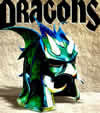
"Dragon Helmut"
Duncan Eagleson
|
Masks
can be made from many different media:
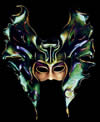
"" "Faerie
Mask"
Duncan Eagleson |
- paper
- leather
- tin
- clay
- latex
- plaster
- papier
mache
- fabric
|
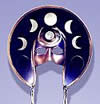 "Lunar Mask"
"Lunar Mask"
Duncan Eagleson |
Activity
4 - Mask, Movement and Music:
| Ask
students to prepare a mask and movement piece, without speaking,
to music of their choice. They are to select the music they
think best reflects the character. The movement to the music
may be interpreted a number of ways. Some students may feel
most comfortable in dance like expression - while others will
find it easier to express movement tied to a specific scene.
They might be relaxing after a hard day at work, or making
supper, or trying to find a lost item, or painting a room.
Allow students to find their best method of expression and
interpretation through the music selected. (20 min.) |
|
| Note:
Following tradition, a mask must be treated with great respect.
Students should be instructed to treat it carefully. Convention
requires that they turn their backs from others when both
putting it on and when taking it off. One must never play
or fool around with a mask. |
Instructional
Strategies:
Structured overview, model building, role playing
Evaluation:
Students should design an evaluation for their own mask work.
It should be out of 50, including at least 15 marks for interpretation,
and at least 15 marks for mask construction. The mask to music
scene should be performed for the class, and the teacher will
mark the work based on the evaluation sheet the student has designed.
Teachers may wish to set additional categories to be included
in the evaluation such as: use of class time, difficulty of work
attempted, lyricism, expression, or use of movement.
Alternative
On-line Activity:
Students
should follow the same steps for activity 1 and 2 . They should
take several close-up digital photos of the mask from different
directions and submit photos of the mask as e-mail attachments.
They should also e-mail a written description of the interpretation
and an evaluation form.
Next
Lesson / Student Lesson
/ Previous Lesson









